Table of Contents
Are you suffering from a stiff back or want to relax your thigh muscles from the previous workout? In that case, you’ll do well to reach for a foam roller. This fitness tool can relax, warm up, and stretch your muscles. However, you’ll achieve the best results when you learn how to use the foam roller properly and choose the most effective exercises.
What Is a Foam Roller?
A foam roller, also known as a massage roller, ranks among fitness tools that can help you massage your entire body. It is used both before and after workout, as part of recovery, and as a therapeutic aid during rehabilitation. This tool is popular among strength athletes, crossfitters, and runners. However, it is also used by people who, for example, sit or stand all day at work and want to stretch, relax, and massage themselves in the evening.
How Does a Foam Roller Work?
Foam rollers are able to create pressure on muscles to promote better blood circulation, and also act on fascia, or the connective tissues. Thanks to this, they are primarily used for warming up muscles, stretching, and myofascial release techniques (Self-Myofascial Release – SMR). Moreover, they also help to massage so-called trigger points, which are small, painful knots that can be felt within the muscle. [1–3]
In the end, using a foam roller offers a wide range of benefits for the proper function of muscles, post-workout recovery, and athletic performance.
If you are interested in learning about all the benefits of a foam roller, you can find them in the article: Foam Roller: Why and How to Use This Massage Tool?

Types of Foam Rollers
These rollers are made from foam with varying levels of hardness and differ in their size and surface type.
- A basic foam roller doesn’t have ridges and is therefore suitable for less intense massages.
- A foam roller with ridges has a hollow core and a harder surface with smaller or larger knobs. This makes it ideal for deep muscle massage.
- A vibrating roller features a vibrating core in addition to the ridges. Thanks to this, the massage can be made more enjoyable and efficient.
- 3-in-1 rollers typically consist of a large foam roller, a smaller ridged roller, and a massage stick. This makes them suitable for a comprehensive full-body massage.
How to Use a Foam Roller?
Self-massage with a foam roller is ideal before a workout, as well as after its completion, to help relax the fatigued muscles. On the following day after exercising, it can support the recovery process. However, you can use a foam roller at any time during the day when you, for example, feel muscle stiffness or back pain. That said, before you start rolling, read about some things to watch out for. [1, 4]
- Rolling is ideally done after warming up your muscles. Just a few minutes on a rowing machine or another exercise machine or after your workout, while your muscles are still warm, is sufficient.
- Place the roller under your back or another muscle group. Then lie on it and roll a few centimetres up and down. You can then adjust it by moving it slightly lower or higher and continue with the self-massage.
- You can increase the intensity of the massage by applying more pressure onto the roller with your own body weight.
- Make sure to avoid injured areas and open wounds. Massaging may be slightly uncomfortable or even mildly painful during the first few seconds, but it should not cause gradually worsening pain.
- The muscle that’s being massaged should be stretched/tensed. For instance, when massaging your calves, straighten your leg and point your toes upward.
- Roll each muscle group for a minimum of 30 seconds and a maximum of 2 minutes. Adjust the duration according to how you feel, and pay attention to how the muscles gradually relax and any discomfort decreases. Then move on to the next muscle group.
- If you come across a tighter spot while rolling, massage that area more thoroughly.
- Make sure to use the foam roller only on muscles. Avoid bones, joints, and the lumbar spine.
- Use the foam roller on larger muscle groups such as the back, buttocks, thighs, or calves. If you need to target smaller muscles or specific problematic areas, use a massage ball instead.
You might be interested in these products:
Top 8 Most Effective Foam Roller Exercises
Using a foam roller allows you to massage your entire body. However, it is most commonly used for relieving tension in the back, buttocks, and thighs. Try the basic exercises listed below, which you can incorporate before every workout.
1. Foam Rolling the Back
- Starting position: Place the foam roller under the upper part of your back. Bend your arms at the elbows and place your palms behind your ears or cross your arms on your chest. Bend your legs, keeping your feet as support points flat on the mat.
- Execution: Breathe deeply and start rolling your back up and down on the foam roller. If you feel a stiff spot, focus on it more thoroughly. The massage will be more intense when you apply more of your body weight to the foam roller. During the exercise, you can adjust the roller’s position up or down as needed. Continue for at least 30 seconds.
- Common mistakes: Moving too fast, rolling over only a small area, holding your breath.
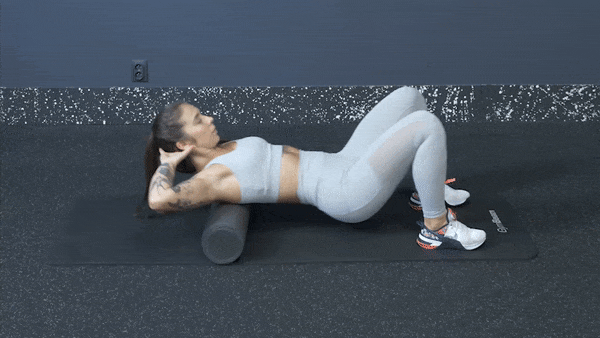
2. Foam Rolling the Lats
- Starting position: Lie on your side, extend your lower arm, and place the foam roller under your shoulder. Bend your upper arm and place it by your side or on the ground in front of you. Bend your legs and anchor your feet against the mat. A foam roller without ridges is more suitable for this exercise.
- Execution: Breathe deeply and start rolling the side of your back up and down on the foam roller. If you feel a stiff spot, focus on it more thoroughly. The massage will be more intense when you apply more of your body weight to the foam roller. You can adjust the foam roller’s position up or down as needed during the exercise. Continue for at least 30 seconds.
- Common mistakes: Moving too fast, rolling over only a small area, holding your breath.
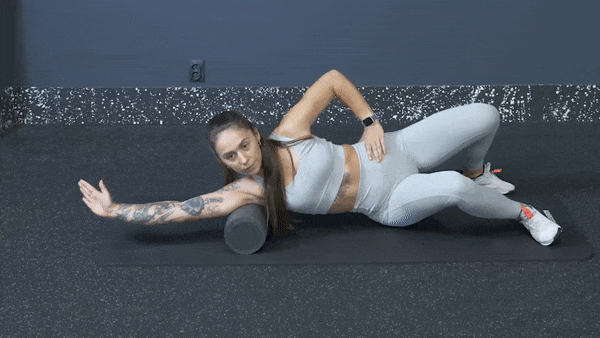
3. Foam Rolling The Buttocks
- Starting position: Sit on the roller, then bend and lift one leg, placing it above the knee of the other supporting leg. Hold it by the ankle with the opposite hand, and place the other palm on the mat for support. Slightly twist your torso to the side of the raised leg.
- Execution: Breathe deeply and start rolling your buttocks up and down on the foam roller. If you feel a stiff spot, focus on it more thoroughly. The massage will be more intense when you apply more of your body weight to the foam roller. During the exercise, you can adjust the foam roller’s position up or down as needed. Continue for at least 30 seconds, then switch sides.
- Common mistakes: Moving too fast, rolling over only a small area, holding your breath.
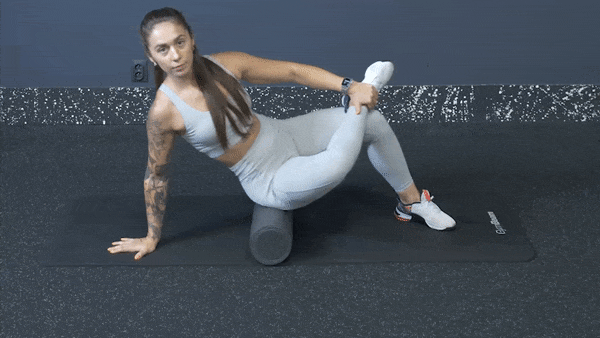
4. Foam Rolling the Back of the Thighs
- Starting position: Sit on the mat and place the foam roller under your thigh. Slightly bend your knee and keep your foot off the ground. Bend the other leg and leave the entire foot on the mat. You can also place it on the leg being massaged to increase the intensity of the massage. Place your outstretched hands behind you as support, with your palms on the mat.
- Execution: Breathe deeply and start rolling your thigh up and down on the foam roller. If you feel a tight spot, focus on it more thoroughly. Increasing the pressure with your own body weight will intensify the massage. You can adjust the foam roller’s position up or down as needed during the exercise. Continue for at least 30 seconds, then switch sides.
- Common mistakes: Moving too fast, rolling over only a small area, holding your breath.
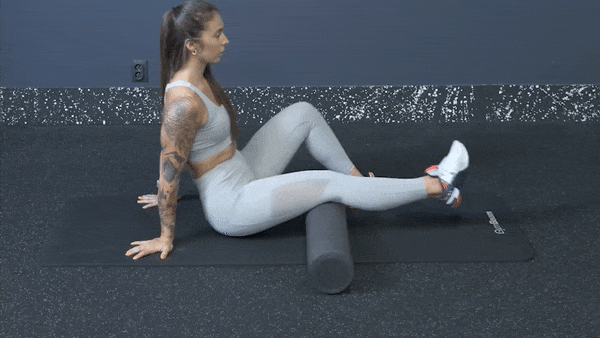
5. Foam Rolling the Side of the Thighs
- Starting position: Lay sideways on the mat and place the foam roller under the outer side of your lower thigh. Support yourself with your extended lower arm on the ground. Bend your other arm and place it to your side. Keep your lower leg extended, and bend your upper leg, resting your foot on the ground.
- Execution: Breathe deeply and start rolling your thigh up and down the foam roller. If you feel a stiff spot, focus on it more thoroughly. Applying more of your own body weight to the foam roller will make the massage more intense. Continue for at least 30 seconds, then switch sides.
- Common mistakes: Moving too fast, rolling over only a small area, holding your breath.
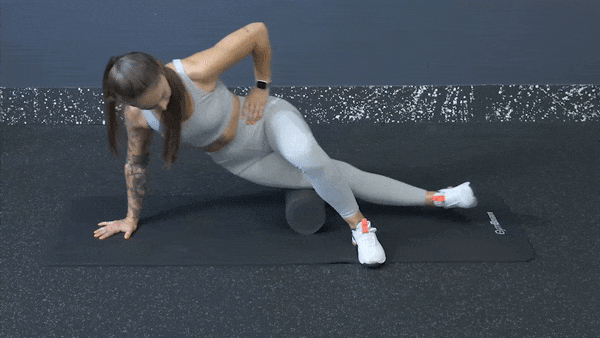
Discover our bestsellers:
6. Foam Rolling the Front of the Thighs
- Starting position: Lie on your stomach on a mat, support yourself with your forearms on the ground, and place the foam roller under the thigh of your extended leg. Bend your other leg and place it to the side for support.
- Execution: Breathe deeply and start rolling your thigh up and down on the foam roller. If you feel a tight spot, focus on it more thoroughly. Increasing the pressure with your own body weight will intensify the massage. You can adjust the foam roller’s position up or down as needed during the exercise. Continue for at least 30 seconds, then switch sides.
- Common mistakes: Moving too fast, rolling over only a small area, holding your breath.
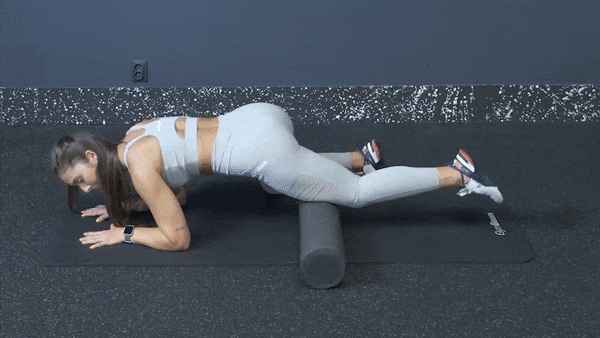
7. Foam Rolling the Inner Side of the Thighs
- Starting position: Lie with your stomach on the mat and support yourself with your forearms on the ground. Bend one leg and place it to the side while placing the foam roller under your thigh. Keep your other leg extended, and anchor your toes into the ground. Bend your arms and support yourself with your forearms.
- Execution: Breathe deeply and start moving your thigh sideways and back on the foam roller. If you feel a tight spot, focus on it more thoroughly. Increasing the pressure on the foam roller with your own body weight will make the massage more intense. Continue for at least 30 seconds, then switch sides.
- Common mistakes: Moving too fast, rolling over only a small area, holding your breath.
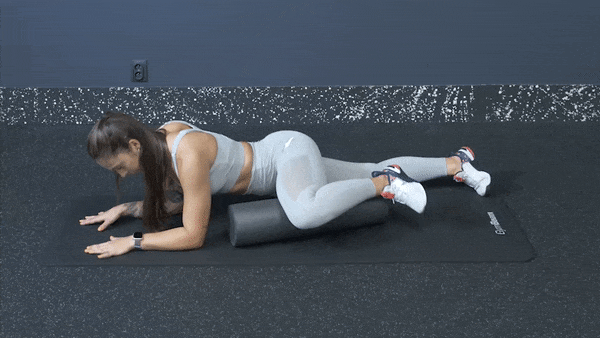
8. Foam Rolling the Calves
- Starting position: Sit on the mat and place the foam roller under the calf of your extended leg. Bend the other leg and keep the foot entirely on the ground as a support point. You can also place it on the leg being massaged, which will increase the intensity of the massage. Place your extended arms as support behind you, with your palms on the mat.
- Execution: Breathe deeply and begin moving your calf up and down the foam roller. If you feel a tight spot, focus on it more thoroughly. Increasing the pressure on the foam roller with your own body weight will make the massage more intense. You can adjust the foam roller’s position up or down as needed during the exercise. Continue for at least 30 seconds, then switch sides.
- Common mistakes: Moving too fast, rolling over only a small area, holding your breath.
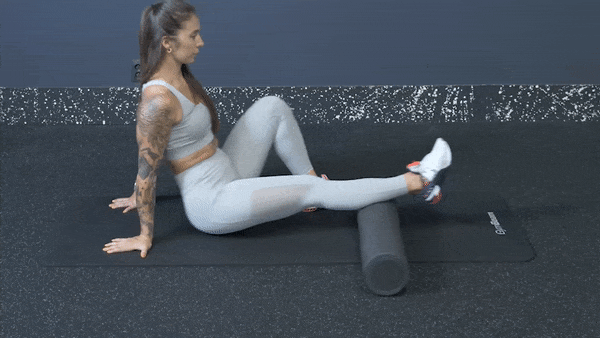
Full-Body Exercises With a Foam Roller
You can find additional effective full-body foam roller exercises in our video.
Where to go from here?
Explore alternative workouts with different fitness equipment and let our articles guide you.
- You can find inspiration for a full-body workout in the article: Top 13 Exercise Ball Exercises for a Full-Body Workout
- Master functional training with a balance half-ball by checking out this article: 10 Best Balance Half-Ball Exercises to Improve Balance, Strengthen Your Back and Entire Body
- Suspension trainer is also suitable for functional training. Learn how to use it and discover effective full-body exercises in the article: How to Exercise With the Suspension Trainer? Try These Effective Full-Body Exercises
- Get a high-quality workout with resistance bands. The best exercises can be found in the article: 30 Full-Body Resistance Band Exercises
What Are the Main Takeaways?
A foam roller is an effective tool for relaxing muscles throughout the entire body, as well as for promoting recovery and athletic performance. You can incorporate these exercises before or after your workout, or at any time during the day when you want to stretch. However, to achieve the best results, always keep in mind the basic rules of foam rolling. These include warming up your muscles before rolling, massaging each muscle group for at least 30 seconds to 2 minutes, and using the foam roller only on muscles.
Did you find this article helpful? If so, share it with your friends and inspire them to try their hand at these foam roller exercises.
[1] Foam Rolling 101: Who Should Do It, When to Do It & How to Do It. – https://www.houstonmethodist.org/blog/articles/2020/jul/foam-rolling-101-who-should-do-it-when-to-do-it-how-to-do-it/
[2] Physiopedia. Fascia. – https://www.physio-pedia.com/Fascia
[3] Physiopedia. Myofascial Pain. – https://www.physio-pedia.com/Myofascial_Pain
[4] Physiotherapy, S. Foam Roller 101: Usage and 10 Exercises to Try. – https://www.stridephysiotherapy.ca/how-to-use-your-foam-roller-top-10-exercises/


Add a comment